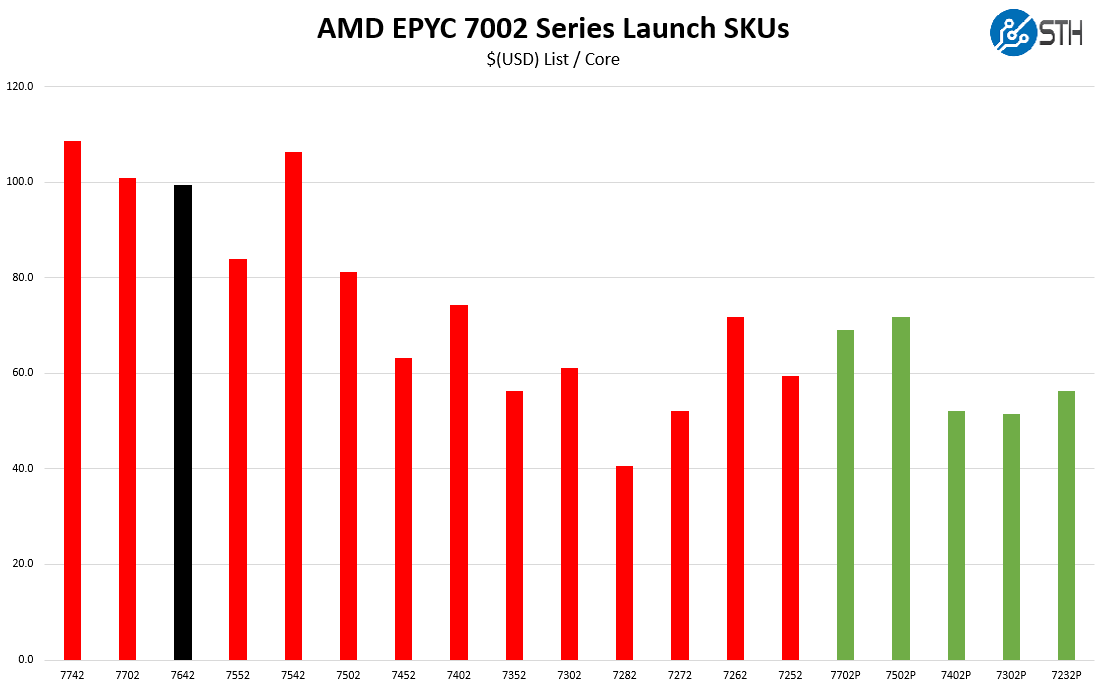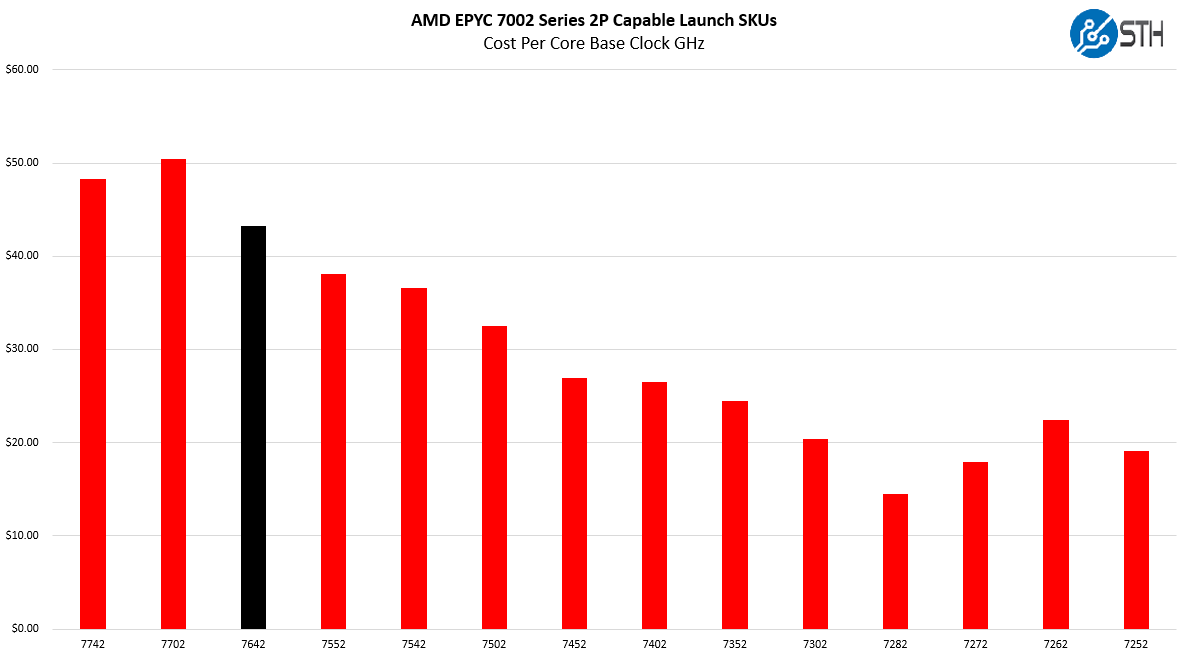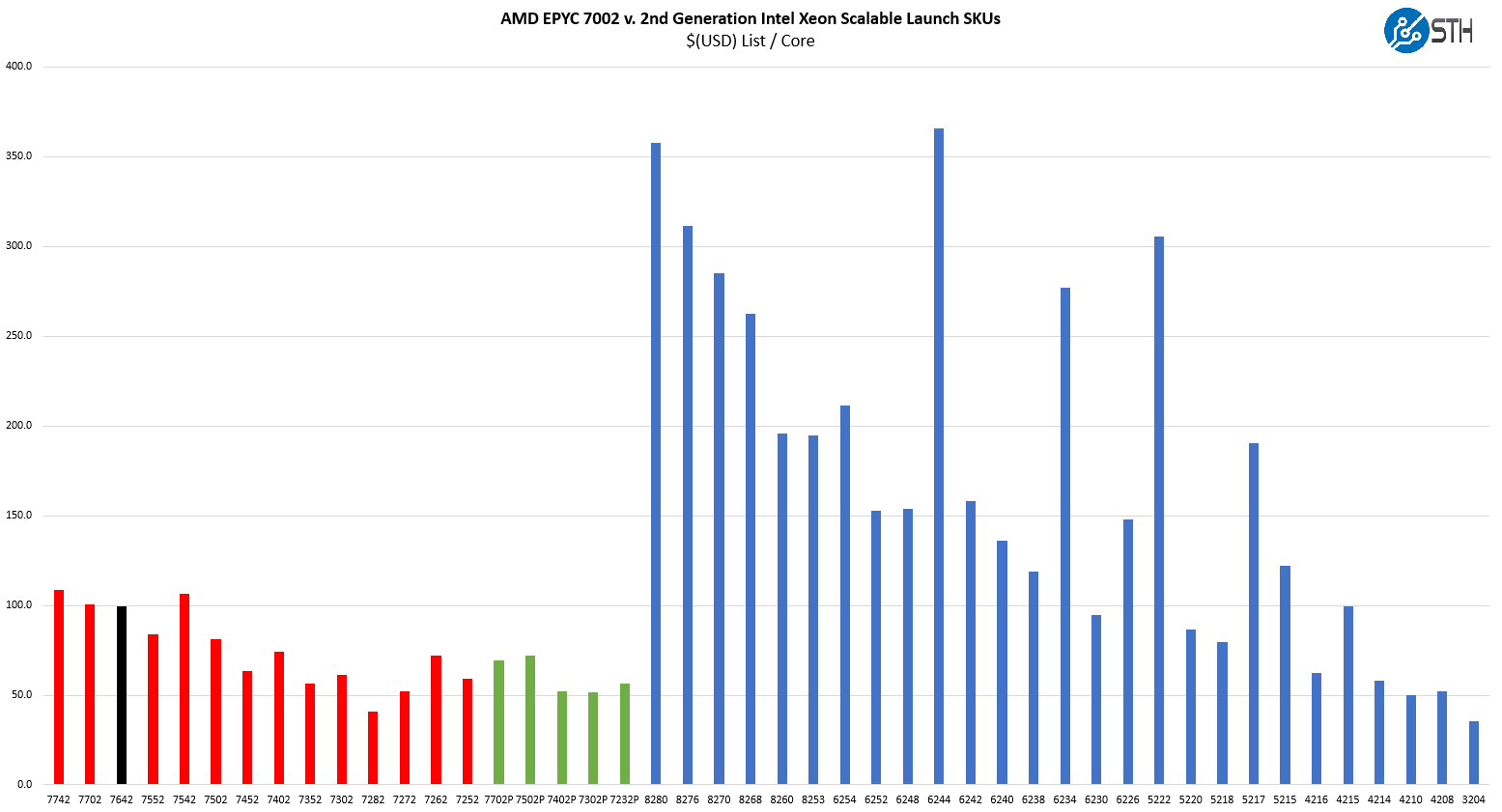AMD EPYC 7642 Market Positioning
These chips are not released in a vacuum instead, they have competition on both the Intel and AMD sides. When you purchase a server and select a CPU, it is important to see the value of a platform versus its competitors.
AMD EPYC 7642 v. AMD Alternatives
When we look at the AMD EPYC 7642 compared to other AMD EPYC 7002 series offerings, we see that it is on the higher end of the pricing spectrum. You can read more about AMD’s SKU methodology in our piece AMD EPYC 7002 SKU List and Value Analysis.

Here you can see that pricing per core is above the AMD EPYC 7702P for single-socket applications and closer to the dual-socket EPYC 7702 variant. That makes sense since this is a dual-socket capable CPU.

When we look at a cost per base core clock (list in $USD/ cores * base GHz), we can see that it is still one of the better values at the higher-end of AMD’s stack.
For single-socket application, our guidance is likely to be closer to the EPYC 7702P which adds 33% more cores at around the same nominal price. Still, EPYC 7642 has better performance per core in most cases which are important as well.
We provided the benchmark figures, but this is a fairly straightforward discussion. If you need more than 32 cores, but less than 64 cores, look at the AMD EPYC 7642. It is one of the easier delineations in the EPYC line.
AMD EPYC 7642 v. Intel Xeon Alternatives
If you have not read the performance section, please do so for context. Then look at this chart which shows the first chart from our AMD EPYC 7642 v. AMD Alternatives section above alongside its Intel counterparts:

The AMD EPYC 7642 does not compete with the Xeon Silver 4200 and Gold 5200 lines, yet it is priced, on a per-core basis similarly. On the higher-end, Intel Xeon Platinum 8260 and higher range, Intel is very competitive on a 2x Intel Xeon Platinum to 1x AMD EPYC 7642 basis. So long as you have a solid TCO model, it is fairly easy to see how Xeon can be competitive here. Intel can simply discount its higher-end chips by 75-80% and be very close. Even at a 70% discount, Intel is probably close enough to stop someone from switching to AMD if the customer is looking to stay.
Realistically, Intel was supposed to have Ice Lake Xeons out with its new microarchitecture, PCIe Gen4, and 48 cores this year when the EPYC 7642 launched. AMD probably targeted the EPYC 7642 as its competitor for the top end Ice Lake Xeon hoping to meet or beat performance on a per-core basis. It then has the 64-core EPYCs as their halo products and that would have been enough to gain market share. Instead, with Intel’s 10nm delays this AMD EPYC 7642 is essentially like later next year’s enormous performance jump halo Xeon, except it is available today from AMD and at a lower price.
Some of our longtime readers may have been wondering why we did a series of quad-socket Intel Xeon Scalable reviews in Q2 2019 along with single and dual-socket systems. This is exactly why. We were building the data set to discuss 2:1 consolidation not just in dual-socket to a single socket, but quad-socket to a dual-socket system. The EPYC 7642 is one of those SKUs that as we look at a dual-socket version will be competitive with quad-socket Intel Xeon.
Final Words
On a per-NUMA node basis, the AMD EPYC 7642 is well beyond what Intel offers if you compare one CPU to another. Perhaps the dual Intel Xeon Platinum 8260 or dual Platinum 8268 configurations are the closest, but then we are effectively looking at a 2:1 consolidation ratio.
Our biggest gripe with the AMD EPYC 7642 is the fact that AMD does not have an EPYC 7642P at $3300 or so. At that price, it offers a midpoint between the 32-core AMD EPYC 7502P and the 64-core AMD EPYC 7702P. It also provides one with new consolidation ratios for two 20-24 core CPUs into the single socket platforms AMD is championing. Then again, based on all of the feedback we are hearing, AMD is not having trouble selling the EPYC 7002 series without this part, so maybe we should be happy with the current SKU stack. Alternatively, it could be part of one of the future SKU waves that are coming.
Overall, this is not a case that requires nuanced opinions for the Xeon comparison. The EPYC 7642 is faster, less expensive, and uses less power, and has PCIe Gen4 that its Intel counterparts lack. Instead, the bigger question is whether this is the right SKU in the AMD EPYC stack for one’s application. We are doing our best to get this data into our reader’s hands to help make that decision.




“Instead, with Intel’s 10nm delays this AMD EPYC 7642 is essentially like later next year’s enormous performance jump halo Xeon, except it is available today from AMD and at a lower price.”
I think that’s the first Intel 10nm dig I’ve read on STH. That paragraph was great.
When is it better than 7702P if used in 1cpu servers?
Brian, you must have missed the glued-together cores article. I find Patrick is very fair with his digs on all sides. lol
I almost feel like AMD openned a wormwhole with these EPYCs and processors have leaped a decade into the future. It’s very overwhelming, to the point of almost feeling unreal.
But I am still with Intel, unfortunately. I have more choices of dual socket motherboards, can easily get a pair of cheap 8280L or 8276L QS (nah, no ES thx) CPUs and build my “poorman” home lab servers, and later when those parts have great price drops I can replace those CPUs with proper released version. So EPYC looks good, but the price and current choice limitations also look “Epic” to me. BTW I don’t need PCIe 4.0 for now – I am still trying hard to saturate all my available PCIe 3 (96) lanes per server. That’s about 80GBytes/s of data bidirectional in real life I think? And I have 2 servers…Well, when I say “cheap”, each CPU is actually cheaper than the motherboard…you get the idea…